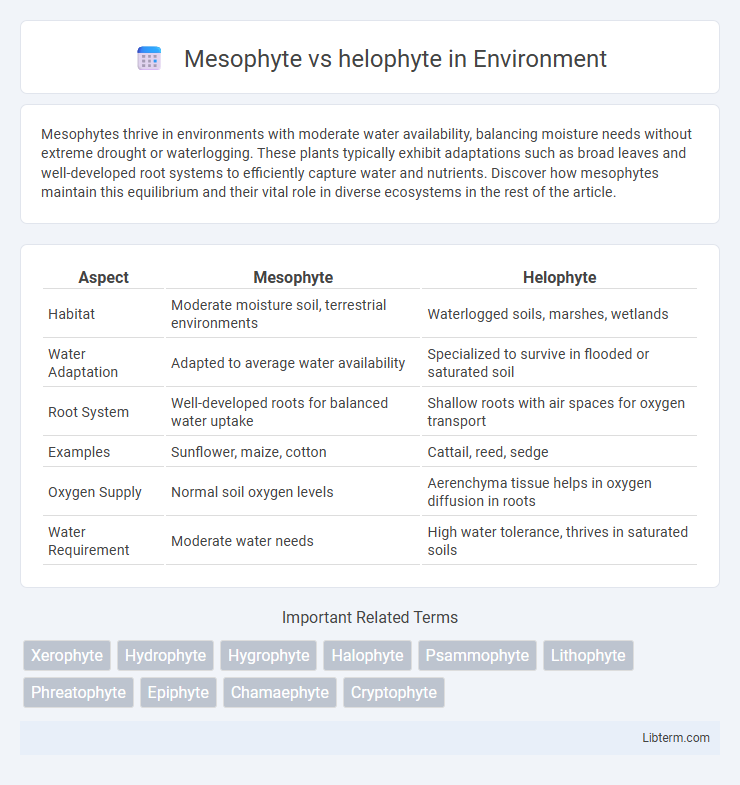Mesophytes thrive in environments with moderate water availability, balancing moisture needs without extreme drought or waterlogging. These plants typically exhibit adaptations such as broad leaves and well-developed root systems to efficiently capture water and nutrients. Discover how mesophytes maintain this equilibrium and their vital role in diverse ecosystems in the rest of the article.
Table of Comparison
| Aspect | Mesophyte | Helophyte |
|---|---|---|
| Habitat | Moderate moisture soil, terrestrial environments | Waterlogged soils, marshes, wetlands |
| Water Adaptation | Adapted to average water availability | Specialized to survive in flooded or saturated soil |
| Root System | Well-developed roots for balanced water uptake | Shallow roots with air spaces for oxygen transport |
| Examples | Sunflower, maize, cotton | Cattail, reed, sedge |
| Oxygen Supply | Normal soil oxygen levels | Aerenchyma tissue helps in oxygen diffusion in roots |
| Water Requirement | Moderate water needs | High water tolerance, thrives in saturated soils |
Introduction to Mesophytes and Helophytes
Mesophytes are plants adapted to moderate environmental conditions with adequate water availability, thriving in well-drained soils without extreme drought or waterlogging. Helophytes, by contrast, are specialized aquatic or semi-aquatic plants that grow mainly in wetlands, marshes, and along water bodies with saturated, oxygen-poor soils. These plant categories differ significantly in root structure, water absorption mechanisms, and habitat preferences, reflecting their adaptation to distinct moisture regimes and ecological niches.
Defining Mesophytes: Key Characteristics
Mesophytes are plants adapted to environments with moderate water availability, neither too dry nor excessively wet. They possess balanced root systems and stomatal regulation that optimize water uptake and retention, enabling efficient photosynthesis under typical terrestrial conditions. Unlike helophytes, which thrive in waterlogged soils with specialized adaptations for anaerobic environments, mesophytes maintain cellular functions in well-drained habitats without extensive waterlogging tolerance.
Defining Helophytes: Unique Features
Helophytes are aquatic or semi-aquatic plants adapted to saturated soils and standing water, characterized by aerenchyma tissues that facilitate oxygen transport in waterlogged environments. Unlike mesophytes, which thrive in moderate moisture without special adaptations, helophytes possess robust root systems and flexible stems to withstand fluctuating water levels. Their capacity for anaerobic respiration and tolerance to low oxygen conditions distinguish helophytes as essential components in wetlands and marsh ecosystems.
Habitat Preferences of Mesophytes and Helophytes
Mesophytes thrive in environments with moderate water availability, such as grasslands and deciduous forests, where soil moisture is well-balanced and neither excessively dry nor waterlogged. Helophytes prefer saturated or waterlogged habitats, including marshes, swamps, and wetland edges, where standing or slow-moving water is common. Mesophytes possess adaptive traits to tolerate periodic drought and flooding, whereas helophytes have specialized root structures like aerenchyma to facilitate oxygen transport in anaerobic soil conditions.
Morphological Differences
Mesophytes possess well-developed root systems with thick cuticles and numerous stomata, adapted for moderate water availability, while helophytes exhibit specialized aerenchyma tissue for oxygen transport and often have rhizomatous roots to thrive in waterlogged soils. Mesophyte leaves tend to be broad with a balanced stomatal distribution, contrasting with helophyte leaves that are often elongated or reduced to minimize water loss in saturated environments. The structural adaptations in helophytes include flexible stems to withstand water currents, which are generally absent in the more rigid mesophyte morphology.
Adaptations to Environmental Conditions
Mesophytes exhibit adaptations such as moderate root systems and stomatal regulation to thrive in environments with adequate water availability, avoiding extreme drought or waterlogging. Helophytes display specialized aerenchyma tissues and extensive rhizome networks that enable survival in waterlogged or aquatic habitats by facilitating oxygen transport and anchorage. Both plant types optimize their physiological and structural traits to balance water uptake, gas exchange, and stability according to their specific environmental conditions.
Water Requirements and Tolerance
Mesophytes require moderate water availability, thriving in environments with balanced soil moisture without prolonged saturation or drought. Helophytes tolerate waterlogged or swampy conditions, often growing in wetlands where their roots are submerged or in saturated soils. Their adaptations allow helophytes to withstand anaerobic soil conditions, unlike mesophytes which are sensitive to excessive water and prefer well-drained substrates.
Ecological Roles and Importance
Mesophytes, thriving in environments with moderate moisture, play a critical role in stabilizing soil and supporting biodiversity in temperate ecosystems by providing habitat and food for various terrestrial organisms. Helophytes, adapted to waterlogged or marshy conditions, contribute significantly to wetland ecosystems by filtering pollutants, preventing soil erosion, and sustaining aquatic and semi-aquatic wildlife populations. Both mesophytes and helophytes act as essential components in nutrient cycling, water regulation, and maintaining ecological balance within their respective habitats.
Examples of Mesophytes and Helophytes
Mesophytes include plants such as sunflowers (Helianthus annuus), maple trees (Acer spp.), and beans (Phaseolus vulgaris) that thrive in moderate water conditions without extreme dryness or saturation. Helophytes like cattails (Typha latifolia), bulrushes (Schoenoplectus spp.), and reeds (Phragmites australis) are adapted to wetland environments and often grow in marshes or waterlogged soils. These examples illustrate the distinct habitat preferences and physiological adaptations between mesophytes and helophytes.
Conclusion: Comparing Mesophytes and Helophytes
Mesophytes thrive in moderate moisture environments with well-drained soils, showing adaptations like broad leaves and moderate root systems for efficient water use. Helophytes, adapted to waterlogged or swampy habitats, possess specialized structures such as aerenchyma and extensive rhizomes to survive low oxygen conditions. The key distinction lies in their habitat preferences and physiological adaptations, with mesophytes suited for balanced moisture and helophytes engineered for saturated, anaerobic environments.
Mesophyte Infographic

 libterm.com
libterm.com